Procura:
A Project Management Model of Concurrent Planning and Design
Sigrid Goldmann
Universitaet Kaiserslautern
in cooperation with the
Center for Design Research
Stanford University
goldmann@informatik.uni-kl.de
Abstract
Procura is a Project Management model which allows the planning and scheduling of agent based design projects in a hierarchical top-down approach. Since the information which is available while the top-level planning and scheduling is done is usually incomplete, the decisions made at this level will often need to be revised as soon as more information becomes available, and conditions change. Procura facilitates the necessary replanning, making use of Redux' [Petrie 93], a design support tool which can keep track of decisions, rejection of decisions, and their rationales. In the Procura model, Redux' tracks planning and scheduling decisions as well as the actual design decisions, thereby integrating planning, scheduling and design, and supporting a notification system which keeps all involved agents (designers as well as scheduling agents) informed about occurring changes.
![]()
1 Background and Motivation
In the past, there have been two different approaches to planning and scheduling: The Operations Research (OR) approach provides tools for graphical planning and scheduling support. CPM and PERT [Obrian84], [Muth63] are the two major planning techniques that have been developed in the course of the OR research. The Artificial Intelligence (AI) approach of automatic planning and scheduling additionally allows a tool to plan a problem by the automatic application of predefined operators. NONLIN [Tate77] and DEVISER [Vere83] are examples for such automatic planners.
The problem of automatic planners, though, is the necessity of predefined operators, which can only be provided in a fairly simple domain. Neither approach supports the user with replanning necessary for practical applications, even though project plans are usually invalidated soon after the begin of the project. Procura supports the user with planning and replanning, as well as scheduling and rescheduling, without trying to build the complex planning operators into the system. This approach will allow us to extend the system by an automatic planner where the domain allows for one, but Procura can also be applied in complex domains where it is not feasible to predefine all possible operators. Additionally, in Procura the planning (i.e. the division of tasks into subtasks), scheduling (the assignment of resources and a start and end time to tasks) and plan execution (the assignment of values to design variables) are interleaved: The part of the plan that has not been executed yet is automatically updated whenever the actual execution of a subtask leads to different results than expected. In other words (since Procura has mainly been developed to support design) the plan and schedule are incrementally revised while the design is going on and is gradually getting more detailed: Planning, scheduling and design take place concurrently.
The Procura model is part of the Process-Link system, which has been developed as a framework for the distributed application of generic engineering services. Process-Link is an agent-based system which consists of several components. It allows a set of application agents to make design decisions and keeps track of decision rationales and rationales for the rejection of decisions, applying the Redux model of revisable design [Petrie91]. In case of an opportunity of improving the current solution of a design problem, the user is notified. (For an example scenario, see [Petrie95].)
To summarize, Procura is intended to solve the following problems:
Our approach works with two basic principles: Scheduling is prediction, and has to be verified (and, if necessary, updated) by comparing the schedule with the actual facts, and a model of design planning and scheduling is needed in order to allow the necessary comparison between the actual design state and the schedule, and make change notification possible. The Procura model extends the Redux model of design revision to build a planning and scheduling model. It does not attempt to automate the planning process, but provides a bookkeeping service which supports the interleaved planning and execution, and facilitates necessary replanning. Rescheduling can partly be done automatically: The original decision about who is going to do what task, and when, is made by the human user, but the propagation of changes through the schedule can be automated.
![]()
2 Working Model
In Redux', a goal is an aim to be achieved by making a decision for it. The decision can be to divide the goal into subgoals, or make variable assignments, or both.
Procura uses the Redux' model and extends it. It allows the user to specify the goals to be achieved in a specific project. For example, the project might be the invention of a new motorcycle, with the main goal "Develop Motorcycle". A task is a chore to be done to achieve a goal. In our system, it is represented as a type of goal with a duration that can be specified by the user. Tasks produce outputs which serve as inputs for other tasks. These inputs and outputs are predicted, and have to be verified by comparing them to the actual inputs and outputs which are determined by making a decision for the task. Inputs and outputs are passed in form of parameters or features, which can represent data as well as physical objects.
Besides tasks, there is another type of goal which can be handled in our system: A scheduling goal corresponds to a task to be solved by scheduling this task. Figure 1 states the relationship between goals, tasks and scheduling goals.
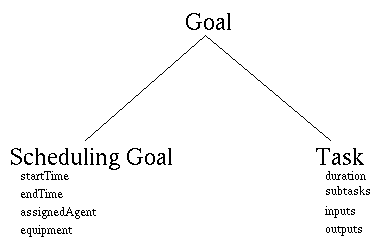
Figure 1
By determining which of the tasks' inputs have to be in place before work on it can be started, and by finding out which tasks produce the required parameters or features, the precedence relationship between the tasks is determined, and a plan can be stated. A plan is a partially ordered sequence of tasks; the order is enforced by the tasks' input/output relationships.
Tasks are done by agents, using shared resources. In this initial version of Procura, only nonconsumable shared resources are considered, namely workers and equipment. An agent is a human or computer using an interface to Procura, which provides a sophisticated notification system and keeps the agent up to date on all changes in the plan, schedule, and design, by which the agent is concerned. A worker is a person who does not have access to Procura and therefore does not get any messages concerning the state of the plan. Equipment can be a tool or machine. Agents and (nonconsumable) resources need to be scheduled to do the various tasks of the plan, by assigning them to tasks for a specified time interval. Each task takes up a certain percentage of an agent's or a resource's time. The sum of all the tasks scheduled for an agent (or resource) at a time is its utilization. At times when an agent or resource is available, its utilization will vary between 0% and 100%. The utilization of an agent or resource that is unavailable (e.g. because of vacation or necessary repairs) must be 0%.
By assigning an agent and the needed resources to each of the tasks of the plan, the timing of each task is determined and the schedule is created. The created schedule is similar to a CPM plan; it states the critical path, and for each task its earliest and latest start and end time.
Procura allows a plan to be hierarchical, i.e. a task can have subtasks,
which form subplans and sub-schedules, so that the overall plan can be
divided into several levels of detail. A task which has subtasks is called
a complex task.
The planning is done top-down: First, the timing of the top-level task
is determined, then it is divided into subtasks, and further planning and
scheduling takes place. (The top-down approach is not mandatory, though.
It is also possible to introduce a low-level task, plan it first, and associate
it to a high level task later in the planning process.)
As mentioned earlier, each task has a corresponding scheduling goal. The task and its scheduling goal are solved by different decisions:
As the planning and scheduling proceeds further down in the tree, more
detailed information about the duration, timing, inputs, outputs and required
resources becomes available, and the planning and scheduling decisions
made at higher levels will have to be corrected, the overall schedule updated.
Procura allows agents to add new inputs to tasks assigned to them, or refuse
inputs that have been stated to be necessary. ("Refusing" and
input for a task means stating that the refused parameter is not needed
to solve the task. It might also happen that an agent finds that it cannot
with an actual value of an input. This problem has to be dealt with "manually",
i.e. outside the system.) In this case, the (predicted) plan and schedule
have to be corrected (adapted to the actual requirements of the "real
world") accordingly, and all concerned agents will be notified. The
same is true for the execution of leaf nodes, i.e. doing decisions: once
a task has been done by making assignments for its output parameters and
features, its actual timing, inputs, outputs and utilized resources become
known. This has to be noted, and the plan accordingly updated.
As the planning and plan execution proceed, conflicts between decisions might occur. For example, an agent might be scheduled to utilize more than 100% of its time, or two agents make variable assignments which are mutually exclusive. The agent who detects the conflict makes it known to the system, which then notifies all concerned agents. These agents will then find a solution for the conflict (using Redux' as a Dependency Directed Backtracking utility, see [Petrie95]), and reject one or more of the decisions involved in the conflict. The conflict is stated as the justification for the rejection, so that the user will be notified if at a later point in time the conflict is resolved by some other means and it is possible to return to the originally rejected decision.
The system also keeps track of already committed tasks. There are three levels of commitment:
The level of commitment has to be determined and stated by the Application Agent. Redux' will send a warning whenever a user attempts to reject a decision that would lead to the rejection of a committed decision.
![]()
3 Architecture
The Project-Link system consists of four parts, each of which are implemented as one or more independent agents:
In this system, a set of Application Agents is "plugged in". The PM and AM components together implement the Procura extensions described here. Figure 2 shows the system architecture. The arrows between the components represent the message flow between the agents.
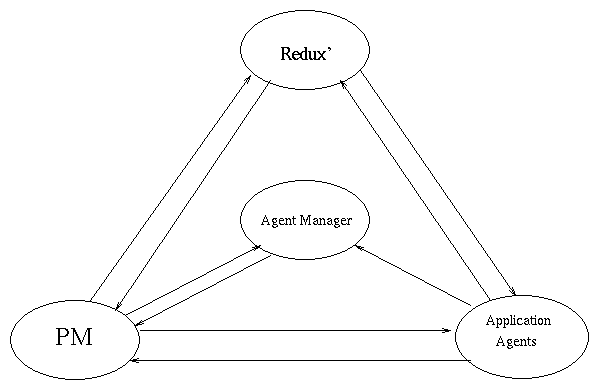
Figure 2
The Project Manager (PM)
(In this version of the tool, the PM agent is a combination of a human user and a tool, which provides decision support and organizes the communication with the other agents in the system.)
The PM is responsible for constructing the plan and schedule according to its hierarchical structure and its tasks' input/output relationships. The PM has a user interface that can show the plan and schedule. It can either show a whole level of the plan or schedule, or it can present a sub-plan or sub-schedule consisting of all the subtasks of a certain task.
The scheduling decisions for all tasks are made by the PM. To do this,
the PM requests information about the availability of agents and equipment,
as well as their capabilities, from the AM. The PM then constructs the
schedule and calculates its critical path, and for each task, its earliest
and latest start and end time.
As the application agents request or refuse inputs to the tasks they are
working on, the PM has to update the plan and schedule and inform all concerned
agents. It is also responsible for making necessary changes (and notify
Redux') as the plan gets more detailed and the higher levels of the plan
have to be updated.
During the execution of the plan, the PM monitors the start and end times
of all tasks, and sends warnings to the concerned agents (the agent assigned
to the task and the agent responsible for its supertask), if a task's latest
start time or end time has been violated.
The Agent Manager (AM)
The AM controls the utilization and availability of all agents and (non-consumable)
resources. For each agent, worker or piece of equipment, it provides a
schedule which states its utilization and availability at each point in
time. When an application agent comes on-line, it will send a message to
the AM, stating its name, location, and a description of its skills and
capabilities. On request, the AM makes this information available to the
PM or other agents. Should an agent or resource become unexpectedly unavailable
(e.g. fall ill), the AM will inform the PM, which then will do re-scheduling
and inform all concerned agents. The same holds, if an agent which is supposed
to be available is not on-line at a certain point in time.
Redux'
By keeping track of the decisions that have been made so far, and in determining the consequences of proposed changes to the plan and schedule, Redux' assists the user with the frequently required replanning. Redux' provides the notification mechanism for conflicts, decision rejections and necessary re-evaluation of rejected decisions. When a decision is rejected, all other decision which are dependent of the rejected decision, are invalidated.
Redux' sends notifications to the concerned application agents when
Redux' also keeps track of committed tasks, and sends a warning if the
user tries to reject a decision that would lead to the invalidation of
an already committed task.
The Application Agents
The application agents are responsible for solving the plan's task(s).
In the solution process, they make planning decisions, which divide tasks
into subtasks, and doing decisions, which make assignments to output parameters
and features. They also state the level of commitment of a decision. For
each of its decisions, an application agent should, on request of the PM,
state the suggested inputs and outputs of the created subtasks. It should
also be able to state the agent skills and equipment properties which are
required for solving the task, and estimate the number of hours the task
will take up of the time of an agent with the stated skill, or a piece
of equipment with the required properties. This information will enable
the PM to make a scheduling decision for the task.
Messages between the Components
To organize the information exchange between the components, a message protocol has been defined. Other than exchanging these predefined messages, the components do not communicate with each other, and no component can call any functions in any of the other components. Therefore, our approach is truly agent-based, and the involved agents can easily be exchanged.
![]()
4 Example
Planning Tasks
We will now illustrate our approach on the motorcycle example we have already mentioned.
The overall task of the example project is T0: "Develop Motorcycle". Let us assume that several decisions have already been made: A planning decision for T0 has been made, creating the subtasks T1: "Specify Requirements", T2: "Design Motorcycle", T3: "Construct Motorcycle", and T4: "Testing". T2 has also been divided into subtasks, namely T2.1: "Design Engine & Frame", T2.2: "Design Carburetor", T2.3: "Design Suspension", T2.4: "Design Wheels & Brakes", and T2.5; "Design Fairing". Figure 3 shows the task hierarchy tree created by these planning decisions.
These two planning decisions have been made by application agents, and Redux' has been notified of the decisions.
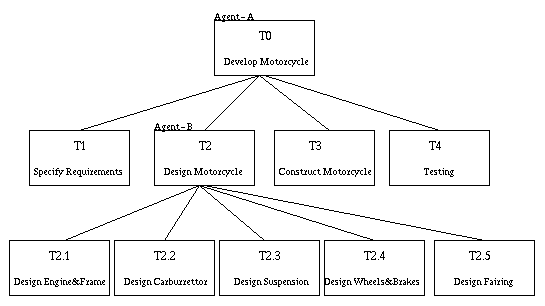
Figure 3
Let us say that T0 has been planned by Agent-A, and the planning decision
for T2 has been made by Agent-B, as stated in Figure 3. The two agents
might have previously been assigned to the tasks by the PM agent, or they
just made their decisions in the Process-Link system without the participation
of the scheduling functionality of Procura.
If now the task hierarchy is presented to Procura's PM agent, it will need additional information to schedule the tasks: For all the created subtasks, it will request the following information from the agents which made the planning decisions: the inputs, outputs, suggested skills and properties of the responsible agent and the needed equipment, and the amount of time the agent and equipment will be needed for. I.e., Agent-A will be requested to state the required information for T0's subtasks T1-T4, and Agent-B will be asked to provide additional information on T2's subtasks T2.1-T2.5.
For example, a message from the PM to Agent-B will look like this:
RequestSchedulingInfo(T2.1)
In reply, Agent-B will send the following message:
SchedulingInfo(task T2.1; duration 40 agent- hours; input requrements_document; output engine_design, frame_design; agent-skill "Design", equipment-property NIL)
This message states that an agent with the skill "Design" will have to spend 40 hours on the task T1, which requires the input "requirements_document, and produces the output parameters "engine_design" and "frame_design". No workers or equipment are needed.
As soon as the PM knows the scheduling information for all the subtasks of T2, it can proceed to state the sub-plan of T2 by ordering the subtasks according to their input/output relationships. It can also generate a schedule by selecting an agent, assigning the required workers and equipment to each subtask, and determining the order of the subtasks which have to be done in series, because of a capacity limit of an agent of piece of equipment assigned to them. Once the schedule is established, the PM can proceed to compute the critical path, and the earliest and latest start and end times.
Assigning Agents
The PM then sends one message per subtask to Redux', stating that the task has been scheduled. For example, the message concerning the task corresponding to T2.1 might look like this:
CreateSchedulingDecision(task T2.1; assigned-agent Agent-B; equipment NIL; startTime day-7; endTime day-14).
As a reaction to this message, Redux' will inform Agent-B of the newly assigned task with the following message:
TaskAssigned(task T2.1; startTime day-7; endTime day-14).
When all the scheduling decisions for the subtasks of T2 have been made, the PM can construct the schedule and calculate the critical path. Figure 4 shows a possible schedule with its earliest and latest start and end times; the thick line marks the critical path.
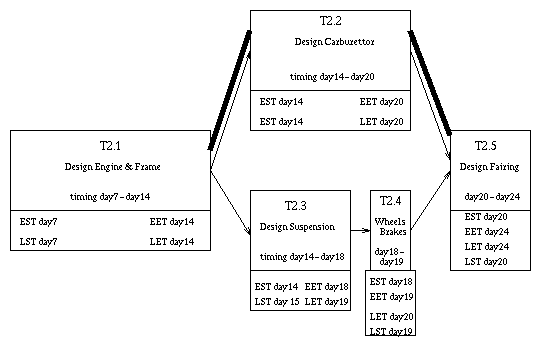
Figure 4
To select the agents and equipment to assign to a task, the PM has to find out which agents with the required skills are available at the time the task has to be scheduled for. For example, to find out the availability of agents capable of working on T2.1, the PM will send the following message to the AM:
RequestAgentUtilization(skill "Design"; start day-4; end day-15).
In reply, the AM will send a message, stating that Agent-A and Agent-B have the skill "Design", and showing the utilization tables for the two agents between the dates "start" and "end". The PM can then determine which agent can work on the task, and assign the task to the agent, stating the timing it has determined with the help of the agent's utilization table. It will then inform the AM that the agent has been assigned a new task, and how much of the agent's time the task will utilize, so that the AM can update the agent's utilization table.
Redux' allows an agent to refuse to work on a task assigned to it. If that happens, the task assignment will be invalidated, and the PM will be required to make a new scheduling decision. It will also notify the AM of the change in the concerned agent's utilization.
Revision
Now suppose that the AM is notified that Agent-B will not be available between day-7 and day-14. The AM will notify the PM that Agent-B will be unavailable to work on T2.1, and the PM will then reject the decision for T2.1:
RejectSchedulingDecision(T2.1)
After finding out the utilization schedule for the other possible agent Agent-C, the PM can make a new decision for T2.1:
CreateSchedulingDecision(task T2.1; agent Agent-C; equipment NIL; startTime day-8; endTime day-15)
Note that the timing for T2.1 has changed (possibly because Agent-C is not available on day-7). This will necessitate a change in the scheduling decisions for all tasks which get their inputs from T2.1. A new schedule has to be constructed and it has to be calculated if the critical path has been violated. If so, the agents responsible for the super-tasks of T2.1 have to be notified by the PM. Should Agent-B become available again, the AM will send a message to Redux', which will then notify the PM that it might go back to the old decision which assigned Agent-B to T2.1. (See [Petrie95] for details.) The PM will then be able to decide if it wants to go back to the earlier decision, which is supposedly the better decision, or if it will stay with the new decision because it would be too much effort to change the schedule again (e.g. if T2.1 or one of its dependent tasks have already been committed).
If now Agent-C makes a doing decision for T2.1, the task will be committed at level 1. The doing decision is sent to Redux' in the following message:
CreateDoingDecision(task T2.1; inputs I1; assignments O1 = x, O2 = y; commitment 1)
Redux' will notify the PM of the decision, which will then find out the actual start and end time of the task, correct the schedule if the actual facts differ from the planned data, and mark the task as "done". Should Agent-C decide to reject and remake the decision, the PM will know that there has already been time spent on the task, so that the committed task cannot be removed from the schedule. Instead, the task stays in the schedule, and a new copy is inserted in order to allow for the additional work that has to be done to solve the task.Figure 5 shows the schedule after such a copy of T2.1 (with a duration of 2 days) has been inserted. Note that in comparison to the schedule shown in Figure 4, the timing of the tasks succeeding T2.1 have been changed in order to allow for the additional time spent on T2.1'.
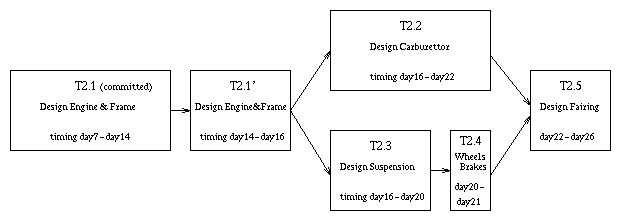
Figure 5
![]()
5 Related Work and Conclusions
As mentioned before, the Procura model is based on the Redux model of revisable design, which can be categorized as a conflict management model. Other related research areas are workflow management, and traditional project management approaches. One example of a workflow management system is the CoMo-Kit tool [Dellen96], [Maurer96], which, like Procura, integrates planning and plan execution, but does not address the issue of scheduling. Procura's novelty in contrast to traditional project management tools are the integration of planning, scheduling and plan execution, the support for incremental revision of the plan and schedule as well as the artifact design, and the notification system which keeps the concerned agents up to date on any changes, while agents who are not affected by a particular change do not get a notification. Also, traditional systems work on a client-server basis, in contrast to the agent-based approach of Procura. The predefined message set that has been defined for the communication between the agents allows any application agents to be plugged into the system by simply defining a software wrapper for the agent which implements the predefined message protocol.
The Procura model (i.e. the PM and AM components) is currently being implemented and will be tested with an example scenario similar to the example introduced in this paper.
The PM is designed to leave the scheduling decisions to a human user. Future work on Procura will include automating the scheduling with the help of the CM agent, introducing the aspect of negotiations between agents into the Procura model. Another future extension of the tool will be the implementation of a notion of hierarchical control and authority, by introducing a notion of the organizational structure between the agents involved in the planning and execution process, and limiting the authority of individual agents to plan and/or do specific tasks.
In the current version of the Procura model, the Redux' agent acts as a central bookkeeping mechanism which has to track all the decisions made inside the system. The possibility to decentralize the system by splitting up the bookkeeping responsibilities between several Redux' agents is currently being considered.
![]()
Acknowledgments
I would like to thank Charles Petrie for all the constructive discussions about the Procura model, and for many helpful suggestions concerning the style of this paper.
![]()
Literature
[Dellen96] B. Dellen, F. Maurer, "Integrating Process
Planning and Execution", WETICE `96, Stanford, USA, June 1996.
[Maurer96] F. Maurer, "Project Coordination in Design Processes",
WETICE `96, Stanford, USA, June 1996.
[Muth63] J. F. Muth and G. L. Thompson, ``Industrial Scheduling'', Prentice-Hall,
Inc., Englewood Cliffs, New Jersey, USA, 1963.
[Obrien84] J. J. O'Brien, ``CPM in Construction Management'', 3. Edition,
McGraw-Hill, Inc., USA, 1984.
[Petrie91] C.J. Petrie, "Constrained Decision Revision", PROC
AAAI-92. Also MCC TR. EID-414-91, December, 1991.
[Petrie93] C. J. Petrie, ``The Redux' Server'', Proc. Internat. Conf. on
Intelligent and Cooperative Information Systems (ICICIS), Rotterdam, 1993.
[Petrie95] C. J. Petrie, Teresa A. Webster, Mark R. Cutkosky, ``Using Pareto
Optimality to Coordinate Distributed Agents'', AIEDAM special issue on
conflict management Vol. 9, pp 269-281, 1995.
[Tate77] A. Tate, "Generating Project Networks", IJCAI-77, Boston,
MA, USA, 1977.
[Vere83] S. A. Vere, "Planning in Time: Windows and Durations for
Activities and Goals", IEEE Trans. on Pattern Analysis and Machine
Intelligence, PAMI-S, No. 3, pp. 246-267, 1983.
![]()
Links to check
The
Next-Link system of which Procura is part , including the Redux'
agent.
The CoMo-Kit
system of the AI group at University of Kaiserslautern,
Germany.
The Project Coordination Workshop of the WETICE '96 conference where this paper has been presented.